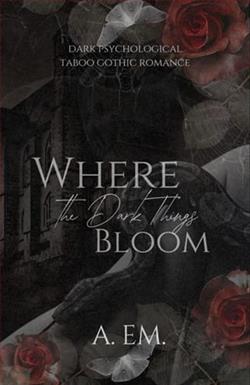
Where the Dark Things Bloom
by A. eM.
Prequel Novella for All the Things We Buried
Dark psychological gothic romance, taboo, step-siblings trope.
She was never supposed to leave, he was never supposed to stay.
When her estranged father dies, Lenore Thorn returns to the one place she swore she’d never set foot in again- a crumbling gothic mansion on the edge of a town that whispers her family’s name in fear.
Her only intention is to sell it and leave for good. But someone is already there.
Dorian Thorn, her stepbrother, never left. Raised beside her but never truly her brother, he has always been possessive, cruel, and unreadable.
He tells her the house is still theirs, that she belongs here and to him.
She resists his cold touch, his hungry gaze, and the way he speaks of their past in riddles.
But when she discovers the darkest secrets that hide behind the walls; blood rituals, missing children, a locked room her father forbade her to enter- she realizes Dorian isn’t the one keeping her here.
The house won’t let her leave.
And neither will he.
.
Read
Where the Dark Things Bloom on http://kissnovel.net
Martial Peak Reviews
A. eM.'s novella, Where the Dark Things Bloom, serves as a prequel to All the Things We Buried, and it is a haunting exploration of dark psychological themes wrapped in a gothic romance. The novella delves into the complexities of familial ties, forbidden love, and the eerie pull of a place that refuses to let go of its inhabitants. This story is a compelling blend of the gothic and the psychological, with a touch of the taboo, making it a fascinating read for those who enjoy their romance with a dark twist.
The novella opens with Lenore Thorn's reluctant return to her childhood home—a decaying gothic mansion that looms ominously on the outskirts of a town that fears her family's name. The setting itself is a character, with the mansion's crumbling walls and shadowy corridors serving as a perfect backdrop for the unfolding drama. The atmosphere is thick with tension and mystery, drawing readers into a world where the past is never truly buried.
Lenore's character is immediately relatable, as she grapples with the conflicting emotions of returning to a place filled with painful memories. Her intention to sell the mansion and leave for good is thwarted by the presence of her stepbrother, Dorian Thorn. Dorian is a complex character, embodying the archetype of the brooding, unreadable male lead often found in gothic romances. His possessive nature and cryptic behavior add layers to the story, as readers are left to wonder about his true intentions.
The relationship between Lenore and Dorian is central to the novella, and it is here that A. eM. explores the taboo step-siblings trope. Their dynamic is fraught with tension, as Lenore resists Dorian's advances while being drawn to him in ways she cannot fully understand. This push-and-pull dynamic is expertly crafted, keeping readers on edge as they navigate the murky waters of forbidden attraction.
As the story unfolds, Lenore discovers that the mansion holds dark secrets of its own. The themes of blood rituals, missing children, and forbidden rooms add an element of horror to the narrative, enhancing the gothic atmosphere. These elements are not merely for shock value; they serve to deepen the mystery and highlight the psychological aspects of the story. The house itself becomes a symbol of the past's inescapable grip, refusing to let Lenore leave and forcing her to confront the demons that lurk within its walls.
One of the novella's strengths is its exploration of the theme of entrapment—both physical and emotional. Lenore's struggle to break free from the mansion mirrors her internal struggle to break free from the past and the complicated relationship with Dorian. The house's refusal to let her leave is a metaphor for the way unresolved issues can haunt us, no matter how far we try to run.
In terms of character development, A. eM. does a commendable job of fleshing out Lenore and Dorian. Lenore's journey from a woman determined to escape her past to someone who must confront it head-on is compelling and relatable. Dorian, on the other hand, remains an enigma for much of the story, but his character is gradually revealed through his interactions with Lenore and the secrets of the mansion. This slow unraveling of his character adds to the suspense and keeps readers engaged.
Comparatively, Where the Dark Things Bloom shares thematic similarities with works like Daphne du Maurier's Rebecca and Emily Brontë's Wuthering Heights, where the setting plays a crucial role in the narrative, and the characters are deeply intertwined with the past. However, A. eM. brings a modern twist to the gothic romance genre by incorporating psychological elements and exploring taboo relationships, making it a unique addition to the genre.
Overall, Where the Dark Things Bloom is a captivating novella that will appeal to fans of gothic romance and psychological thrillers. A. eM. masterfully weaves together themes of love, loss, and the inescapable pull of the past, creating a story that is both haunting and thought-provoking. The novella's rich atmosphere, complex characters, and intriguing plot make it a must-read for those who enjoy stories that linger long after the last page is turned.
In conclusion, if you are looking for a story that combines the eerie allure of a gothic mansion with the psychological depth of a dark romance, Where the Dark Things Bloom is a perfect choice. It is a tale that will draw you in with its mystery and keep you captivated with its exploration of the human psyche and the shadows that dwell within us all.























Reviews 0
Post a Reviews: